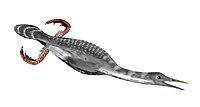Kanguk Formation
Appearance
| Kanguk Formation | |
|---|---|
| Stratigraphic range: | |
| Type | Geological formation |
| Sub-units | Eglinton Member |
| Underlies | Eureka Sound Formation |
| Overlies | Hassel Formation |
| Thickness | up to 365 metres (1,200 ft)[1] |
| Lithology | |
| Primary | Shale, siltstone |
| Other | Sandstone, tuff |
| Location | |
| Coordinates | 79°14′24″N 92°21′58″W / 79.24°N 92.36613°W |
| Region | Northwest Territories, Nunavut |
| Country | |
| Type section | |
| Named for | Kanguk Peninsula |
| Named by | Souther |
| Year defined | 1963 |
The Kanguk Formation is a geological formation in the Northwest Territories and Nunavut, Canada whose strata date back to the Late Cretaceous. Dinosaur remains are among the fossils that have been recovered from the formation.[2]
It was first described in the Kanguk Peninsula of the Axel Heiberg Island, along the shore of the Stand Fiord by Souther in 1963.[3] The formation occurs throughout the Sverdrup Basin and the southern Queen Elizabeth Islands.
Lithology
The Kanguk Formation is composed of dark shale and siltstone with interbeds of sandstone, bentonite and tuff.[1] Thicker sandstone and conglomerate beds occur in the western reaches in Eglinton Island.
Fossil content
| Birds of the Kanguk Formation | ||||||
|---|---|---|---|---|---|---|
| Genus | Species | Location | Stratigraphic position | Abundance | Description | Images |
|
Indeterminate[2] |
 | |||||
See also
References
- ^ a b Lexicon of Canadian Geological Units. "Kanguk Formation". Retrieved 2009-03-07.
- ^ a b c Weishampel, David B; et al. (2004). "Dinosaur distribution (Late Cretaceous, North America)." In: Weishampel, David B.; Dodson, Peter; and Osmólska, Halszka (eds.): The Dinosauria, 2nd, Berkeley: University of California Press. Pp. 574-588. ISBN 0-520-24209-2.
- ^ Geological Survey of Canada Map 36-1959

